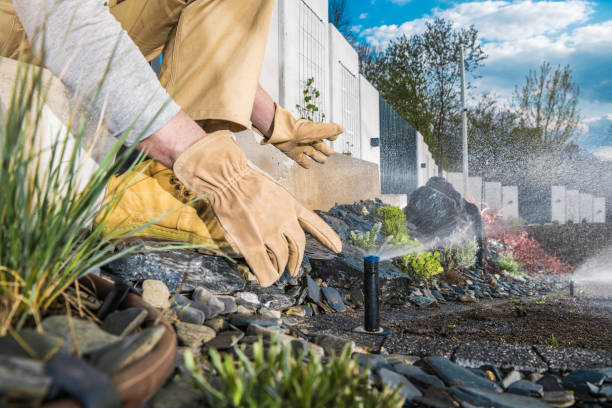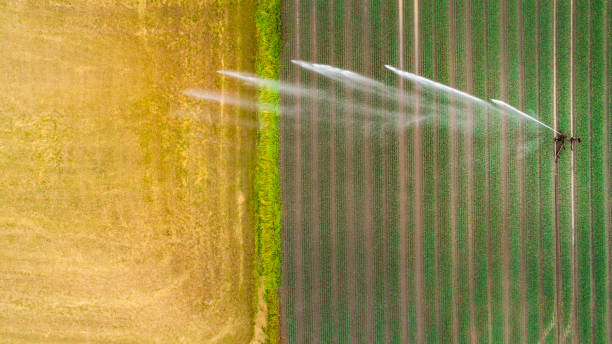
Agriculture is the cornerstone of many economies worldwide, and its productivity heavily relies on effective irrigation techniques. This article will go over several types and methods of irrigation, providing an in-depth understanding of their functionality, advantages, and shortcomings.
Surface Irrigation
- Furrow Irrigation: Involves creating small channels or ‘furrows’ between crop rows. Water flows down these furrows, allowing crops to absorb necessary moisture.
- Basin Irrigation: Commonly used for rice farming where entire field is flooded with water.
- Border Irrigation: Suitable for large fields with a gentle slope. Here, water is spread across the field’s width.
- Flood Irrigation: Water is allowed to cover the soil surface entirely without any barriers.
Subsurface Irrigation
This method involves delivering water directly to the root zone underground. It has higher efficiency than surface irrigation systems but requires more investment initially.
- Drip or Trickle Irrigation: The most common type where water drips slowly onto soil surface or directly into root zone from a network of tubes or pipes.
- Sub-Irrigation: Used in areas where the water table is high. Water is supplied by raising the water table through a system of ditches or pipes.
Pressurized Irrigation Systems
Pressurized systems apply water under pressure through pipes or other tubing. These are more efficient but also more costly compared to gravity-based systems like surface irrigation.
- Sprinkler System: Resembles natural rainfall as it sprays water into air which then falls onto crops.
- Center Pivot System: Consists of sprinklers mounted on moving towers, irrigating in a circular pattern.
- Lateral Move System: Similar to center pivot but moves in a straight line.
Manual Irrigation
In this method, water is distributed across the land by manual labour using buckets or watering cans. It’s labor-intensive and less efficient but prevalent in small-scale farming where other methods are not feasible.
In the end, the type of irrigation method chosen depends on several factors like crop type, soil structure, water availability and quality, financial resources, and local climate. By understanding different irrigation techniques, farmers can make informed decisions for their agricultural practices.
Exploring Different Types of Irrigation Systems and Their Importance
Agriculture significantly contributes to the worldwide economy, with irrigation playing a pivotal role. Understanding what irrigation is and why it holds such importance can provide deeper insights into agricultural practices worldwide.
Irrigation can be defined as the artificial application of water to land or soil. This procedure assists in helping grow agricultural crops, maintaining landscapes, and revegetating disturbed soils in dry areas during periods of inadequate rainfall. In essence, it’s a method used to ensure that plants get enough water to thrive.
Exploring Different Types of Irrigation
- Increasing Agricultural Productivity: Irrigation aids in increasing productivity in agriculture by providing an optimal amount of water needed for plant growth. By controlling water supply, farmers can improve crop yield and quality.
- Ensuring Crop Survival during Drought: During periods of inadequate rainfall or drought conditions, irrigation becomes crucial in maintaining crop growth and survival by compensating for the lack of natural precipitation.
- Flexibility in Crop Selection: With effective irrigation systems, farmers have flexibility in the selection of crop varieties as they are not solely dependent on rain-fed agriculture.
The Roles of Irrigation
- It increases agricultural productivity thus contributing to economic growth.
- It creates employment opportunities in rural areas.
- It enhances food security by stabilizing production throughout the year.
- It reduces dependency on unpredictable rainfall patterns for farming activities.
- It helps maintain landscapes and ecosystems that depend on regular water supply.
- Implemented effectively, it aids soil conservation efforts.
- It promotes revegetation of disturbed soils.
- Managed correctly, it replenishes groundwater levels by increasing infiltration rates.
The correct implementation and management of irrigation are essential to maximize these benefits while mitigating potential negative impacts, like overuse of water resources or deterioration of water quality.
The Evolution of Irrigation
Irrigation practices have evolved significantly over time. Traditional methods include surface irrigation, where water is distributed over the soil surface by gravity, and sub-surface irrigation, where water is applied below the soil surface. These methods have their own sets of benefits and limitations.
In recent years, modern techniques like sprinkler irrigation and drip irrigation have gained popularity. These methods are more efficient in terms of water use and can be tailored to the specific needs of different crop types.
Despite the method chosen, the primary goal remains to provide a sufficient amount of water to crops in a controlled manner to ensure optimal growth. Thus, understanding irrigation and its importance is crucial for anyone working in agriculture or interested in sustainable farming practices.
Detailed Analysis of Various Types of Irrigation System
Surface and sub-surface irrigation are two primary techniques in agriculture that help to distribute water evenly across the fields. Each method has its unique benefits and challenges, which we will delve into in this section.
Surface Irrigation
Surface irrigation is one of the oldest methods used by farmers worldwide. This technique involves directing water flow over the field surface, allowing it to seep into the soil and reach the root zone.
- Basin irrigation: Ideal for flat or slightly sloping lands, this method involves flooding an enclosed area with water.
- Furrow irrigation: Used for crops planted in rows, such as maize or potatoes. Water is directed into small channels or ‘furrows’ between the rows.
- Border irrigation: Similar to basin irrigation but used on larger fields with a gentle slope. Water flows down a strip of land contained by small earth ridges.
Despite being labor-intensive and less efficient than other modern methods, surface irrigation remains popular due to its low cost and simplicity.
Sub-Surface Irrigation
Sub-surface irrigation involves delivering water directly to the root zone beneath the soil surface. This method is more controlled as it reduces evaporation loss and facilitates higher efficiency.
- Drip Irrigation: Also known as trickle irrigation, this employs a network of tubes that deliver water directly to the base of plants.
- Subsurface Drip Irrigation (SDI): In SDI, drip lines are buried below the soil surface. This can be a more efficient way to irrigate certain crops like corn and cotton.
- Bubbler Irrigation: Useful for tree crops like orchards where water is supplied directly around the base of each tree via small bubblers.
Sub-surface irrigation systems tend to be more expensive than surface methods due to the cost of the equipment. However, they offer improved water efficiency and can reduce weed growth.
Comparison: Surface vs. Sub-Surface Irrigation
| Surface Irrigation | Sub-Surface Irrigation | |
| Cost | Low | High |
| Efficiency | Lower | Higher |
| Labor Intensity | High | Low |
| Reduction in Evaporation Loss | Lower | Higher |
In conclusion, the decision between surface and sub-surface irrigation techniques depends on several factors including the type of crop, landscape, available resources, and specific needs of a farming operation. Both these irrigation techniques have their pros and cons which make them suitable for different agricultural scenarios.
Understanding Different Types of Irrigation: A Comprehensive Guide
Sprinkler irrigation is an innovative method that has significantly transformed agricultural practices. This technique, primarily used in areas with irregular terrain or sandy soil, has many advantageous features that set it apart from traditional irrigation methods. Here, we delve into the particulars of sprinkler irrigation, its advantages and disadvantages, and its variety of applications.
Exploring Different Types of Irrigation Systems for Agriculture
Sprinkler irrigation is a technique where water is distributed through a system of pipes and sprayed into the air in the form of droplets similar to rainfall. This system functions through pressurized pumps that drive water to the surface through sprinklers or nozzles strategically spread across a field. With precise control over water distribution and coverage, this method mimics natural rainfall effectively benefiting various crop types.
Exploring Different Irrigation Methods
- Efficient Water Usage: Sprinkler systems use water more efficiently than traditional methods by reducing evaporation and run-off.
- Versatility: It can be used for almost any type of crop and adaptable to nearly all types of soil.
- Flexibility: Sprinkler systems can be adjusted based on changing watering requirements or weather patterns.
- Prevents Soil Erosion: The system’s controlled application reduces the risk of soil erosion.
Exploring the 3 Types of Irrigation Systems
- Dependence on Wind: If it’s too windy, the water may not reach intended areas.
- High Initial Cost: Installation costs can be high due to the need for pumps and infrastructure.
- Maintenance Requirements: Regular maintenance is required to ensure maximum efficiency.
Exploring Different Types of Agricultural Irrigation Systems
- Fixed Sprinklers: These are stationary sprinklers installed permanently underground with only the sprinkler heads visible.
- Rotating Sprinklers: These are designed to rotate and spray water in a circular pattern.
- Oscillating Sprinklers: These move back and forth, spraying water in a rectangular pattern.
Despite the initial costs and maintenance requirements, sprinkler irrigation systems offer numerous benefits such as flexibility, efficiency, and versatility. It is now commonly used not just in agricultural fields but even in residential lawns or golf courses.
Adopting sprinkler irrigation can be a strategic decision for farmers seeking to optimize their crop productivity while conserving water. With proper management and utilization, it can significantly increase agricultural profitability while promoting sustainable farming practices.
Comprehensive Guide to Different Types of Irrigation and Their Impact on Agricultural Practices
Waterlogging in the context of irrigation refers to an excess of water in the soil. Ideally, there should be a balance between water retention for plant growth and drainage to avoid stagnation. If water accumulates excessively, it results in waterlogging. This can have negative effects on crop health and yield. Understanding the causes, effects and prevention strategies can significantly aid farmers and agricultural practitioners.
Causes of Waterlogging
- Excessive Rainfall or Irrigation: Over-irrigation or heavy rainfall that exceeds the soil’s absorption capacity often leads to waterlogging.
- Inadequate Drainage: When natural or artificial drainage systems are inefficient or blocked, it can cause water to accumulate.
- Clayey Soil Texture: Soils with high clay content tend to retain more water due to their compact structure, leading to potential over-saturation.
- High Water Table: Areas with a high groundwater table are more likely to experience waterlogging as excess rainwater or irrigation seeps down.
Effects of Waterlogging
- Reduced Soil Aeration: Excess water displaces air from soil pores leading to reduced oxygen availability for roots.
- Stunted Plant Growth: Reduced oxygen supply hinders root respiration, affecting nutrient uptake and impairing plant growth.
- Promotion of Harmful Organisms: Prolonged saturation creates conducive conditions for root rot diseases and pest infestations.
Prevention of Waterlogging
- Crop Rotation: Different crops have different moisture requirements. By rotating crops seasonally, fields get time to dry out effectively.
- Proper Irrigation Management: Avoid over-irrigation by following appropriate irrigation schedules based on the crop’s water needs and soil type.
- Soil Conditioning: Organic matter and compost can be added to clayey soils to improve their structure, enhance drainage and prevent waterlogging.
- Drainage Systems: Ensuring an efficient drainage system can help excess water to flow out of the field, reducing the risk of waterlogging. This might involve constructing ditches, trenches or installing subsurface drains.
By understanding the causes, effects and preventive measures of waterlogging in irrigation systems, practitioners can significantly reduce associated risks, ensuring optimum crop yields and preserving soil health. It is crucial for sustainable agricultural practices to manage irrigation effectively as part of an integrated approach to land stewardship.

